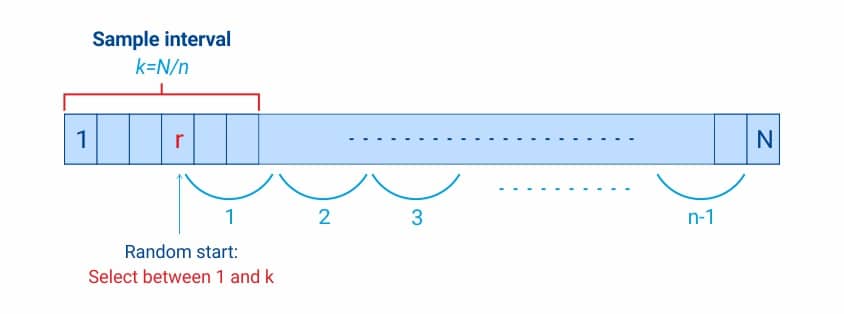1 in k Repeated Systematic Sampling With N 10 Again N 60
What is systematic sampling?
Systematic sampling is a statistical method that researchers apply to zero downwardly on the desired population they want to research. Researchers calculate the sampling interval past dividing the entire population size past the desired sample size. Systematic sampling is an extended implementation of probability sampling in which each member of the group is selected at regular periods to form a sample.
Systematic sampling definition
Systematic sampling is defined equally a probability sampling method where the researcher chooses elements from a target population by selecting a random starting point and selects sample members after a fixed 'sampling interval.'
Select your respondents
For example, in school, while selecting the captain of a sports squad, nigh of our coaches asked usa to telephone call out numbers such as 1-v (one-n) and the students with a random number decided by the bus. For case, three would be called out to be the captains of unlike teams. It is a non-stressful selection process for both the coach and the players. There'south an equal opportunity for every member of a population to be selected using this sampling technique.
What are the steps to form a sample using the systematic sampling technique?
Here are the steps to form a systematic sample:
Stride one: Develop a defined structural audition to start working on the sampling aspect.
Footstep two: As a researcher, figure out the ideal size of the sample, i.e., how many people from the unabridged population to choose to be a part of the sample.
Step three: Once you decide the sample size, assign a number to every member of the sample.
Step four: Ascertain the interval of this sample. This will be the standard distance between the elements.
For instance, the sample interval should exist 10, which is the result of the division of 5000 (N= size of the population) and 500 (n=size of the sample).
Systematic Sampling Formula for interval (i) = N/n = 5000/500 = 10
Pace five: Select the members who fit the criteria which in this case will exist 1 in 10 individuals.
Pace six: Randomly choose the starting fellow member (r) of the sample and add together the interval to the random number to go along calculation members in the sample. r, r+i, r+2i, etc. volition be the elements of the sample.
How systematic sampling works
When yous are sampling, ensure you lot represent the population fairly. Systematic sampling is a symmetrical process where the researcher chooses the samples after a specifically defined interval. Sampling similar this leaves the researcher no room for bias regarding choosing the sample. To empathise how systematic sampling exactly works, take the example of the gym form where the instructor asks the students to line upward and asks every tertiary person to stride out of the line. Here, the teacher has no influence over choosing the samples and can accurately represent the class.
Systematic sampling example
For instance, if a local NGO is seeking to form a systematic sample of 500 volunteers from a population of 5000, they tin can select every tenth person in the population to build a sample systematically.
What are the types of systematic sampling?
Here are the types of systematic sampling:
- Systematic random sampling
- Linear systematic sampling
- Round systematic sampling
Let's take a closer await at these sampling techniques.
Systematic random sampling:
Systematic random sampling is a method to select samples at a particular preset interval. Every bit a researcher, select a random starting point betwixt ane and the sampling interval. Beneath are the example steps to gear up a systematic random sample:
- First, calculate and fix the sampling interval. (The number of elements in the population divided by the number of elements needed for the sample.)
- Choose a random starting point between 1 and the sampling interval.
- Lastly, repeat the sampling interval to choose subsequent elements.
Linear systematic sampling:
Linear systematic sampling is a systematic sampling method where samples aren't repeated at the end and 'northward' units are selected to exist a function of a sample having 'N' population units. Rather than selecting these 'n' units of a sample randomly, a researcher can apply a skip logic to select these. It follows a linear path and then stops at the end of a particular population.
This sampling or skip interval (grand) = N (full population units)/n (sample size)

How is a Linear systematic sample selected?
- Suit the entire population in a classified sequence.
- Select the sample size (n)
- Calculate sampling interval (k) = N/northward
- Select a random number betwixt 1 to k (including k)
- Add together the sampling interval (g) to the chosen random number to add the adjacent fellow member to a sample and repeat this procedure to add remaining members of the sample.
- In instance k isn't an integer, you can select the closest integer to N/n.
Circular systematic sampling:
In round systematic sampling, a sample starts again from the same point once again after ending; thus, the name. For example, if N = vii and northward = 2, k=3.5. In that location are two probable means to form sample:

- If we consider thousand=3, the samples will exist – ad, be, ca, db and ec.
- If nosotros consider m=4, the samples will be – ae, ba, cb, dc and ed.
How is a round systematic sample selected?
- Calculate sampling interval (grand) = N/north. (If N = xi and northward = two, then grand is taken as 5 and not half dozen)
- Kickoff randomly between i to N
- Create samples by skipping through k units every time until you select members of the entire population.
- In the instance of this method, in that location will be Due north number of samples, dissimilar k samples in the linear systematic sampling method.
Difference betwixt linear systematic sampling and circular systematic sampling:
Hither is the difference between linear systematic sampling and circular systematic sampling.
| Linear Systematic Sampling | Round Systematic Sampling |
| Create samples = k (sampling interval) | Create samples = N (total population) |
| The get-go and endpoints of this sample are distinct. | It restarts from the start indicate once the entire population is considered. |
| All sample units should be arranged in a linear fashion prior to option. | Elements will exist arranged in a circular manner. |
What are the advantages of systematic sampling?
Here are the advantages of systematic sampling.
- It's extremely elementary and convenient for the researchers to create, carry, analyze samples.
- As at that place's no need to number each member of a sample, it is improve for representing a population in a faster and simpler manner.
- The samples created are based on precision in member selection and costless from favoritism.
- In the other methods of probability sampling methods such equally cluster sampling and stratified sampling or non-probability methods such as convenience sampling, there are chances of the clusters created to be highly biased which is avoided in systematic sampling every bit the members are at a fixed altitude from one another.
- The factor of hazard involved in this sampling method is extremely minimal.
- In example in that location are various members of a population, this sampling technique can be beneficial because of the fifty-fifty distribution of members to course a sample.
Other probability sampling techniques similar cluster sampling and stratified random sampling can be very unorganized and challenging due to which researchers and statisticians accept turned to methods like systematic sampling or simple random sampling for improve sampling results. It consumes the to the lowest degree time as it requires a selection of sample size and identification of the starting point for this sample, which needs to be continued at regular intervals to form a sample.
Select your respondents
When to apply systematic sampling?
Let's take an case where you want to course a sample of 500 individuals out of a population of 5000; y'all'd have to number every person in the population.
Once the numbering is done, the researcher tin select a number randomly, for instance, 5. The 5th individual will be the first to be a role of the systematic sample. Subsequently that, the 10th member will be added into the sample, so on so forth (15th, 25th, 35, 45th, and members till 4995).
Here are iv other situations of when to apply Systematic Sampling:
- Budget restrictions: In comparison to other sampling methods similar uncomplicated random sampling, this sampling technique is more suitable for conditions where there are budget restrictions and too the extremely uncomplicated accomplishment of the written report.
- Elementary implementation: Every bit systematic sampling depends on the defined sampling intervals to make up one's mind the sample, information technology becomes simple for the researchers and statisticians to manage samples with more respondents. This is because the time invested in creating samples is minimal, and the cost spent is besides restricted due to the periodic nature of systematic sampling.
- Absenteeism of data pattern: There are specific data that don't have an arrangement in identify. This data tin be analyzed in an unbiased fashion, using systematic sampling.
- Depression risk of data manipulation in enquiry: It is highly productive while researching a broad subject, particularly when in that location'southward a negligible risk of data manipulation.
Sampling with QuestionPro Audience
QuestionPro Audience has a global sample of 22 million+ survey respondents who are double-opted and mobile-set to participate in all levels of market research and brand research. Demand niche panelists like gamers, building contractors, directly become in affect with our niche panelists.
Source: https://www.questionpro.com/blog/systematic-sampling/
0 Response to "1 in k Repeated Systematic Sampling With N 10 Again N 60"
Post a Comment